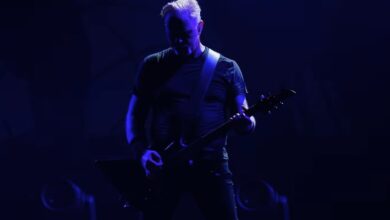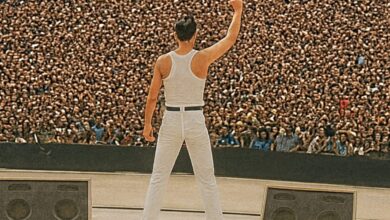The Sound of Silence Reborn: A Bold Modern Interpretation
The quiet introduction in Dan Vasc’s interpretation of “The Sound of Silence” immediately signals a performance built on intention and emotional pacing. Rather than diving into the intense and commanding vocals many anticipate from his metallic style, he allows the opening measures to unfold with gentle breathing space. This restraint respects the folk origins of the piece while subtly preparing the listener for a striking transformation. The silence becomes a tool, a presence within the music that shapes tension and expectation. By purposely delaying the dramatic rise, he creates a powerful contrast, turning the evolution of the track into a narrative that reflects the emotional meaning behind the lyrics.
The song itself has traveled a long and fascinating journey through history. Emerging from Simon & Garfunkel’s early catalog in the 1960s, it began as a softly sung reflection on isolation and communication, eventually growing into an iconic anthem recognized across multiple generations. When Disturbed reintroduced it to the world with a brooding symphonic-rock approach in 2015, new audiences connected with its timeless weight. With that reputation established, any artist who chooses to reinterpret it carries the burden of comparison. Dan Vasc takes that challenge and chooses evolution instead of imitation, bringing theatrical depth and cinematic intent that pushes the composition into a fresh realm while honoring its emotional core.
Much of this cover’s brilliance rests on how Vasc controls intensity. He navigates between soft vulnerability and soaring strength with deliberate care, allowing the music to expand like a story unfolding scene by scene. Soft-spoken phrases in the early lines create a sense of closeness, as if a single listener is being addressed personally. Gradually the arrangement swells—strings rising, percussion gradually building, harmonies thickening in layers. By the time the dramatic climax arrives, it feels monumental. The shift from a gentle whisper to a full symphonic roar is crafted to feel like a storm breaking after distant thunder has been grumbling beneath the horizon.
Vocally, Vasc displays the versatility that has earned him millions of devoted followers. His lower tones carry clarity and gentle pathos, grounding the subdued verses with sincerity. When the moment calls for an eruption, he expands his sound instead of simply increasing loudness, giving the notes density and emotional fullness. This ability to balance gentleness and raw projection creates an arc that listeners feel with both their hearts and their bodies. He never loses focus on storytelling, and even in the grandest section, each lyric remains distinct and packed with meaning.
The arrangement elevates the performance further, transforming the cover into an experience rather than a simple re-recording. The piano rings out softly like small signals in a quiet corridor before growing into a foundational force beneath the orchestral layers. Strings glide and swell, offering support like an emotional tide, while percussion enters only when the atmosphere demands intensity. This meticulous layering constructs a sonic world that feels large and cinematic, letting the listener sink into the shifting drama and absorb every rising moment as if watching a film score unfold from scene to scene.
The video reflects this same sense of focus by insisting that the music remain the central force. There are no overly busy edits, attention-seeking visuals, or unnecessary effects crowding the screen. Instead, the visual style invites audiences to connect directly with the expression in his face, the delivery of each phrase, and the atmosphere shaped by the music alone. This quiet confidence implies that spectacle isn’t needed when artistic intent is powerful enough. Viewers respond to that authenticity, reinforcing that the core of the performance is compelling on its own merits.
Fans who have long held this song close find new reasons to appreciate it in this bold presentation. Its themes remain deeply relevant in the modern world: people searching for connection, struggling to communicate in a society filled with noise yet lacking true understanding. Vasc embraces that timeless relatability, allowing his voice and the sweeping orchestration to emphasize the emotional urgency behind the words. This isn’t only a revisit of a classic; it is the continuation of a message that still resonates strongly today, reminding listeners why the song has carried such significance for more than half a century.
As the track climbs toward its highest peaks, a dramatic shift takes place. The soft contemplation that fills the early verses evolves into something larger than one person’s quiet confession. The performance takes on the atmosphere of an anthem glowing with intensity, as though the singer is suddenly addressing every soul in a crowded arena. The orchestral foundation rises in tandem with his expanding voice, and what once felt intimate becomes majestic. It is here where Vasc’s metal background brings added fire to the emotional revelation.
A unique achievement of this interpretation is how it bridges audiences that don’t always share musical interests. Listeners devoted to folk music can hear the respect for the original melodic structure. Fans of rock and metal can feel the surge of adrenaline when the arrangement reaches climactic heights. Admirers of cinematic composition can lose themselves in the orchestral movements that feel like a grand film ending. Few performances manage to serve such varied communities without dulling their creative identity, yet this cover manages to speak fluently to all of them at once.
Emotional sincerity is one of the greatest pillars of this rendition. Many singers attempt to sound intense, yet intensity without conviction often feels hollow. Vasc avoids that trap through genuine connection to the lyrics. When he expresses the famous line “silence like a cancer grows,” the weight of vulnerability is evident in his delivery. Listeners aren’t merely impressed by his technical range; they feel the experience behind every sustained note. This emotional truth is why the comment sections overflow with reactions speaking of chills, tears, and feeling profoundly moved.
The impact of this cover extends beyond the music itself. In an age of online interaction where content spreads through emotional moments and shareable highlights, its structure lends itself perfectly to social engagement. The gradual build makes viewers urge others to “wait for it,” and the climactic explosion becomes the very moment people replay and forward to friends. This shared anticipation and release heightens the communal experience, fueling the cover’s viral momentum across platforms.
Vasc’s interpretation also marks an important step in his artistic evolution. His successful “Cover-Up” series has repeatedly delivered beloved classics reinvented through a cinematic rock lens, but this particular song demands deeper introspection than most. Revisiting and refining it over multiple releases indicates that he continues to challenge himself, returning to the music not to repeat it, but to explore its depths with growing maturity. That persistence reveals a passion for understanding a song completely before considering the journey complete.
The technical construction of the track deserves praise as well. Symphonic-metal productions can sometimes come across as cluttered when aggressive guitars, layered vocals, and dynamic orchestration all fight for prominence. This mix avoids that pitfall by allowing every sound a distinct space, maintaining clarity even in the biggest sections. Reverb widens the environment without losing the intimacy of the vocal, and the instrumental balance keeps emotion at the forefront. The listener feels both the hugeness of the arrangement and the personal quality of the storytelling simultaneously.
Ultimately, what makes this cover unforgettable is how it reimagines the role of silence. Rather than treating it as empty space between louder moments, Vasc treats quietness as a living force that grows and transforms with the narrative. Each pause heightens anticipation, each breath feels meaningful. The contrast that silence provides is what allows the explosive ending to land with such massive emotional weight. It isn’t merely loudness that creates impact—it is the careful shaping of quiet leading up to it.
Everything about this performance reinforces why “The Sound of Silence” continues to resonate deeply decades after its creation. It embraces the roots of the original while confidently stepping into modern cinematic production, creating something reverent yet daring. It captures the heart of a timeless song and allows it to speak in a bold new voice. That is why this version stays alive in the minds of those who listen long after the final chord disappears into the dark, letting silence remain as powerful as the sound that preceded it.





